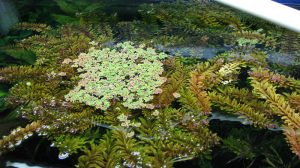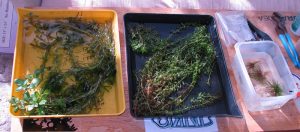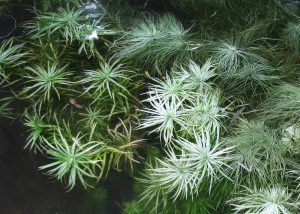
You might want to remove a carpeting plant that grows at a much faster rate than desired, such as this arrangement of Eriocaulon aquaticum.
Once you keep a high energy planted aquarium tank for a while, you are bound to eventually keep hitting such high densities of plant biomass that several difficulties tend to arise: your plants may grow so thick that it is hard to keep the tank clean, the aquascape may have gone out of balance or it becomes difficult to keep up with growing demands for nutrient and carbon dioxide. In another scenario you may have left town for a few weekends in a row and the tank becomes so overgrown that only a complete overhaul can restore aesthetic and biological order to your freshwater aquatic garden. In any case, a planted tank occasionally needs to be bushwhacked and replanted and there a few things the aquarist can do to make the rebirth of their aquarium go as smoothly and efficiently as possible.
Before I even do the actual overhaul of a planted tank, I try to take in all of the required aquarium maintenance that needs to be performed before I start the actual bushwhacking. I find it is a much better practice to do all of these servicing chores before trimming all the plants because you are much more likely to put off more aquarium work after the planting is done. You should clean all filters, top off your dosing, clean the Carbon Dioxide injection mechanism, whether this is a CO2 reactor or diffuser and by golly, make sure that have plenty of carbon dioxide to last you for at least a couple of weeks after a major replanting. Don’t forget to spruce up your lighting system by either replacing your lamps, wiping off the bulbs, reflectors or splashguards and make sure that any fan guard Is free of dust. Also, make sure that all of your replacement water is at a suitably close temperature and pH to add to the tank as soon as it is ready. If you need to spread out duration of the plant tank overhaul, I suggest doing the chores on the first day and then you’ll be able to really take your time in redoing the aquascape on a following day.
Now before you start the actual weed wacking, make sure that you have all the proper tools handy: you’ll likely need some long handled scissors, some large sturdy tweezers, and a few containers to hold your clean plants and trimmings. If you keep plants that look very different from each other it’s very easy to place all your “re-use” plants in the same container but if your aquarium specializes in different varieties of mosses, Cryptocorynes, Rotalas or Eriocaulaceae, you might want to take some precautions to keep you from having to differentiate between closely related plant varieties; even if you’re an expert it’s a pain to tell the difference between the collapsed state of emerged grown plants, especially when you are trying to tell apart a some of the Syngonanthus or Eriocaulon species. For some plants you can use large shallow trays that you can fill with water or cover with clingwrap and for other more robust species like Anubias and Ferns I like to either throw them into a ziplock bag or tupperware container. Since I often have many similar looking plants, I will label some ziplock bags to hold just one species or type of plant before I even start trimming. Not only do labeled bags help me keep track of what plants are what, when I am done removing plants what I am left with is a clear layout of all the plants I am going to re-use in the layout, as well as the height and quantity of the different plant groups. With such a clear depiction of my plant mass it is much easier to begin planning the replanting of the new aquascape.

You may have to do some serious trimming to a plant tank that has a veil of stem plants that are hogging all the surface and light.
Make sure you turn off all your filters and CO2 dosing before you start messing with the tank because water motion will only blow around all the detritus you will undoubtedly disturb. While you are trimming your plants you will have to decide whether to groom unwanted leaves and ratty stems now or later. You can either trim off the tops of the plants you want and keep trimming the plants until you’ve removed all that you want to keep. The remaining stem-bottoms may or may not be reusable and the choice to regrow or discard these trimmings will be up to you. If you like the size and placement of this small patch of lower stems you may be able to regrow the plant you desire from this stumpy base and sell or trade off the choice top stems but the capacity for regrowth will also depend on the species of plant. Stem plants from the Ludwigia, Limnophyla, Hygrophyla, Syngonanthus and Rotala genera will likely already have a ton of new buds already appearing at nearly every internode that was left behind. Regrowth from this kind of patch can come back in very quickly and densely and if this is the kind of result you are seeking then by all means leave the patch of stems to regrow.

With a lot of different plants removed from a planted aquarium, you’ll want to use plenty of containers to keep them all.
However, certain stem plants do not respond well to regrowing in this manner and you will not get the desired result with Pogostemon, Ludwigia inclinata var verticillata or Ammania ‘Bonsai’. These plants may regrow some buds from the bottom stems but they are more likely to stunt or rot. If you decide to replant from the stem tops, try to remove as much of the bottom stems and roots as possible. At this point you’ll want to cut the roots below the surface of the substrate and use your sturdy tweezers to pull out unwanted stems individually. If you try to pull out more than one stem base at a time you risk disturbing a large area of substrate and making a real big mess. For the real heavy, root balling, substrate feeding plants such as Eriocaulon, Echinodorus and Cryptocoryne, you will most certainly need to reach a pair of long scissors with a curved cutting edge deep beneath these plants to cut the roots away from the rootball. Even then you’ll want to pull out the plant in stages of uprooting and letting the substrate fall away from the roots a few times until enough of the substrate has been freed from the the substantial roots of these substrate feeding plants. After having uprooted all the plants that need to be refreshed, you’ll probably want to take a break to allow the plant matter and detritus to sink or float for a few minutes so that it can be more easily siphoned off of the substrate and hardscape, and then skimmed from the surface with a regular fish net.

Desirable plants that will be reused or traded are kept in labeled bags, all the trimmings and old plants go in a separate bucket headed for the compost bin.
Although some of the new-school aquatic gardeners have developed a habit of planting an aquarium mostly without water in the tank, I like to plant my water plants in water, the old fashioned way. If your plant tank aquarium substrate had any areas which were particularly well planted with heavy root forming plants for four to six months, that area of the substrate may have become locally depleted of certain key nutrients. There’s no better time to infuse some root tabs into your substrate than before replanting a fresh grouping of heavy root feeders. When it comes to replanting your old or refreshed aquascaping theme, try to anticipate what your pants look like in 4-6 weeks, and plan their growth rates and pattern to coincide with your desired layout and focal points. You’ll still need to groom your plants into submission to get the look you desire but proper placement of your plants will still make it easier to reach your aesthetic goals. Once you’ve got your tank completely replanted filled up and flowing, you’ll want to readjust your tank dosing regimen to reflect the reduced biomass of your new layout. If you were dosing a certain amount of NPK, Iron and CO2 before, you will likely need a much smaller amount and you should reduce your dosing amount to prevent unwanted nutrient or carbon dioxide buildup. Once your plants continue growing again, you’ll have to gradually increase your CO2 bubble rate and other dosing to keep pace with your once again flourishing water garden.





Really loved your article. I have got so much information that I might get helpful for my aquarium hobby. I also love to share information. So, you can check my blog too.
https://aquatalkies.com/